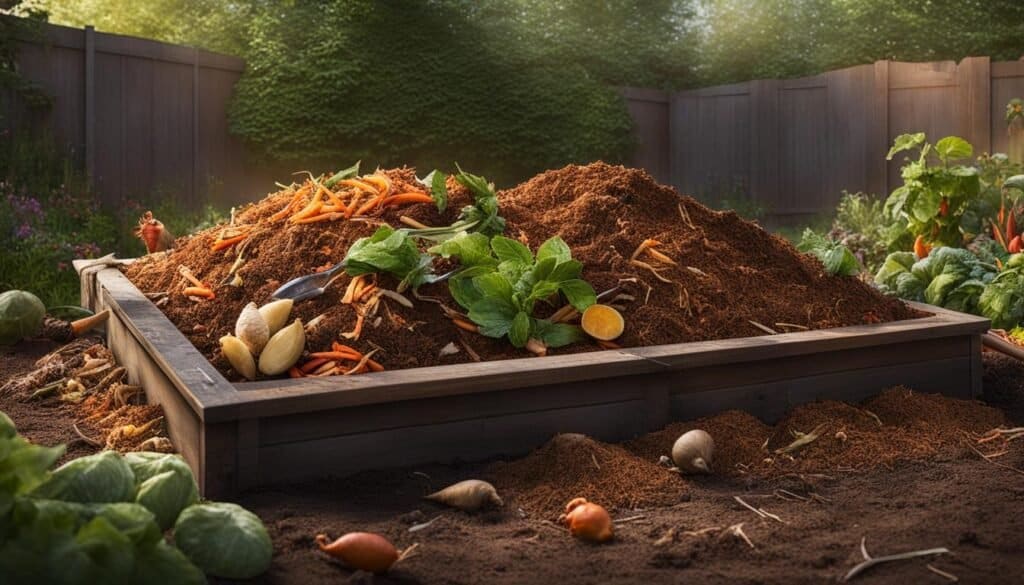As environmental stewards, we’re constantly considering how our daily habits and choices can help reduce waste and create a sustainable future. One important aspect of this eco-conscious lifestyle is the responsible disposal of disposable products. By adopting green product disposal recommendations and waste reduction practices, we can work together to preserve the environment and diminish ecosystem breakdown caused by pollution. Let’s explore these green tips, so that each of us can contribute to a cleaner and healthier planet.
Key Takeaways
- Reduce, reuse, and recycle to minimize disposable product waste.
- Composting food waste can greatly contribute to reducing greenhouse gas emissions.
- Choose eco-friendly alternatives such as renewable energy sources and LED lighting.
- Embrace sustainable transportation methods, like biking and public transit.
- Practice responsible waste management in both home and workplace settings.
- Adopt environmentally friendly practices during leisure activities, like travel and holidays.
- Participate in local green community initiatives and promote sustainability among family and friends.
38 Eco-Friendly Tips for Green Product Disposal
Here is a list of 38 eco-friendly tips for green product disposal and waste management, along with relevant statistics and data:
Reduce, Reuse, Recycle
- Reduce consumption of single-use items like plastic bags, disposable cutlery, and water bottles. Opt for reusable alternatives instead
- Reuse items like scrap paper, jars, and containers whenever possible
- Recycle materials like paper, metals, glass, and some plastics. Check local guidelines on what can be recycled
Sustainable Purchasing
- Buy products made from recycled, organic, or sustainably-sourced materials
- Purchase products with minimal packaging to reduce waste
- Buy locally grown food to reduce transportation emissions
- Support brands and companies with good sustainability practices
Proper Disposal
- Dispose of hazardous waste like chemicals, batteries, CFL bulbs at designated collection sites79
- Avoid pouring chemicals or oil down the drain or into the environment9
- Use composting to divert organic waste from landfills. Food waste makes up 24% of landfill waste22
Energy Conservation
- Install energy efficient appliances and electronics with the ENERGY STAR label
- Switch light bulbs to energy efficient LED or CFL bulbs
- Unplug devices when not in use to avoid phantom load power drainage
Sustainable Cleaning
- Use non-toxic, eco-friendly cleaning and personal care products
- Create DIY cleaning products from ingredients like baking soda, vinegar and lemon
Food Waste
- Store food properly and check expiration dates to reduce spoilage
- Freeze leftovers to preserve them and reduce waste
- Eat less meat – agriculture accounts for 24% of greenhouse gas emissions
- Compost food scraps to divert waste from landfills – about 30% of waste could be composted
Water Conservation
- Install low-flow faucets, toilets and shower heads
- Collect rainwater for uses like watering plants
- Fix any leaks – small leaks waste significant amounts of water
Paper Conservation
- Avoid paper items like paper towels and use washable alternatives instead
- Print double-sided and use scrap paper
- Buy paper products made from recycled materials
Textile Waste
- Donate old clothing instead of throwing them away
- Purchase secondhand clothing to reduce waste
- Wash clothes in cold water to conserve energy
- Air dry clothing instead of machine drying when possible
Miscellaneous Tips
- Bring reusable bags when shopping
- Use reusable containers for takeout and leftovers
- Choose products made from materials that are biodegradable
- Avoid products with excessive packaging
- Cancel junk mail and paper billing when possible
- Recycle electronics, batteries and other hazardous waste
- Switch from single-use plastic items to reusable alternatives like straws and water bottles
- Educate yourself and others on sustainability practices
- Support local environmental initiatives and nonprofit organizations
Statistics
- The global smart waste management market is projected to surpass $4 billion by 2027, indicating growing investment in sustainable waste management technology and infrastructure
- About 75% of waste generated in the US is recyclable, but the recycling rate is only around 35%
- Plastic waste accounts for over 18% of landfill waste
- Only 9% of plastic waste globally is recycled
- Organic waste like food and yard trimmings makes up over 50% of landfill waste in most countries
The list covers a wide range of practices from the 3 R’s to purchasing decisions to waste disposal methods and beyond. Implementing even a few of these tips can significantly reduce a household’s environmental impact.
Embracing an Eco-Conscious Lifestyle: The Impact on Our Planet
Choosing to live an eco-conscious lifestyle not only benefits the environment but also improves our own living conditions. By opting for pollution-free electricity generated from wind and solar power, one can ensure their household positively affects the environment all year round. Embracing the three Rs—reduce, recycle, reuse—is crucial for minimizing home waste.
Purchasing carbon offsets and using programmable thermostats aligns with sustainable living, while upgrading to LED lighting and conserving water are straightforward ways to limit energy and resource consumption. Further, teaching families to decrease food waste and sealing homes properly for energy efficiency fall under proactive, eco-friendly daily habits that significantly reduce environmental impact.
“The greatest threat to our planet is the belief that someone else will save it.” – Robert Swan
One of the key factors in maintaining an environmentally friendly household is proper waste management. By learning about various waste disposal methods and integrating them into your daily routine, you can significantly reduce your home’s environmental impact. Some of these methods include:
- Composting kitchen and garden waste.
- Recycling paper, plastic, and metal products.
- Using reusable containers and bags for shopping and storage.
- Supporting local, eco-conscious businesses.
Let’s not forget, improving air quality is another essential aspect of living an eco-conscious lifestyle. Planting trees, avoiding the use of harsh chemical cleaners, and regularly maintaining household appliances can help to maintain good air quality.
| Aspect of Eco-Conscious Lifestyle | Example | Environmental Impact |
|---|---|---|
| Clean Energy | Solar panels, wind turbines | Reduced greenhouse gas emissions |
| Compost | Kitchen and garden waste | Improved soil health, reduced landfill waste |
| Carbon Offsets | Purchasing carbon credits | Supports emissions reduction projects |
| Waste Management | Recycling, reusing, and reducing waste | Conservation of resources, reduced landfill waste |
| Air Quality | Improved ventilation, use of non-toxic products | Healthier indoor environment, reduced pollution |
In conclusion, adopting an eco-conscious lifestyle involves making mindful choices that benefit both the planet and your well-being. By taking simple yet meaningful steps, you can make a significant difference in preserving the environment for future generations.
Powering Your Home with Sustainable Energy Choices
Adopting sustainable energy choices is essential in promoting a greener and healthier lifestyle. By investing in renewable power sources, utilizing smart technology, and reducing household waste, it’s possible to greatly decrease our environmental footprint. Let us take a closer look at these eco-friendly tips that promote sustainable living while powering your home with clean energy.
Investing in Renewable Power Sources
Renewable energy has become an increasingly viable option for homeowners seeking to reduce their environmental impact. Harnessing power from sources like wind and solar energy not only helps in reducing greenhouse gas emissions, but also promotes cleaner air quality and a sustainable future.
To begin your journey towards utilizing renewable energy, consider installing solar panels on your roof or researching wind energy providers in your area. These renewable power sources provide an environmentally-friendly alternative to traditional fossil fuels.
Energy Conservation with Smart Technology
Smart technology is a valuable tool in the quest for energy conservation. Programmable thermostats, for example, help optimize your home’s heating and cooling by automatically adjusting the temperature based on your preferences and habits. This translates to reducing energy consumption and lowering utility costs.
Additionally, upgrading to LED lighting conserves energy and lasts longer than traditional incandescent bulbs while providing the same amount of light. It’s worth exploring other smart devices, such as energy-efficient appliances and home automation systems, which can further minimize your energy consumption.
Reducing Household Waste Through the Three R’s
Implementing the three R’s—reduce, recycle, reuse—is crucial in reducing household waste and conserving resources. By minimizing the waste that ends up in landfills, it’s possible to lessen the demand for raw materials and help preserve the environment for future generations. Below are some eco-friendly tips for practicing the three R’s:
- Reduce: Limit your use of single-use products and purchase items with minimal packaging.
- Recycle: Sort your recyclables properly and become familiar with local recycling guidelines.
- Reuse: Invest in reusable items like shopping bags, water bottles, and food containers to minimize waste.
By embracing these sustainable energy choices, you are actively contributing to a healthier and more eco-friendly planet. Remember that even small adjustments to your lifestyle can have a significant impact on the environment and help promote a greener future for all.
Sustaining the Environment One Step at a Time

In our daily lives, we have the power to make a significant impact on the environment by embracing eco-conscious commuting, transportation, and green shopping habits. By rethinking our choices and making small adjustments to our habits, we can better sustain our environment, reduce our carbon footprint, and support a greener future.
Eco-Conscious Commuting and Transportation
Our transportation choices can have an immense effect on the environment. By choosing to bike, use public transport, or carpool, we can help reduce emission levels and greenhouse gases that contribute to climate change. Even opting for electric or hybrid vehicles can have a positive ripple effect on our planet’s health.
Green Ways to Shop and Run Errands
Making sustainable choices while shopping and running errands goes a long way in reducing our environmental footprint. A few simple actions we can take include:
- Remembering reusable shopping bags and water bottles to reduce plastic waste
- Supporting local businesses that source their products responsibly
- Planning efficient errand routes to minimize fuel consumption
- Reusing takeout containers and opting for packaging-free options when available
- Choosing products with minimal or eco-friendly packaging
Taking these essential steps in our daily lives supports the greater goal of sustaining the environment for future generations. As individuals, we can make a meaningful difference simply by being mindful of our choices and using our resources wisely.
Green Product Disposal Recommendations in the Office

An eco-friendly office can contribute significantly to environmental wellness by adopting green product disposal methods and sustainability protocols. These adaptations not only minimize waste but also promote a healthier planet and cultivate environmental consciousness among coworkers.
- Reusable lunch containers: Encouraging the use of reusable lunch containers in the office helps reduce single-use plastic waste and the need for disposable containers.
- Recycled materials: Investing in computer bags made from recycled content, using recycled paper for printing, and promoting other office supplies made from sustainable materials is a practical way to lessen the workplace’s environmental impact.
- Office sustainability: Simple actions like turning off lights and electronics when not in use, using energy-efficient appliances, and properly disposing of electronic waste and batteries can create a more sustainable office environment.
- Soy ink: Soy-based inks, a cleaner alternative to traditional petroleum-based inks, reduce air-polluting compounds and are ideal for office printing needs.
- Reusable supplies: Encouraging the sharing and reuse of office supplies among coworkers, such as pens, staples, and paper clips, can significantly decrease waste and resource consumption.
- Environmental consciousness: Cultivating an environmentally aware workplace culture instills long-lasting habits that benefit not only the office but also the planet. Encourage coworkers to participate in green initiatives, such as recycling programs and community clean-up events.
Taking these steps to implement green product disposal practices and promote eco-friendly habits in the office environment creates a culture of sustainability and encourages ongoing environmental stewardship among coworkers. Every small action can make a lasting impact on our planet and help to preserve it for future generations.
Green Your Move and Travel Plans
Being environmentally conscious is no longer just about turning off the lights when you leave your home. Sustainable practices can extend to other important aspects of life, such as moving and travel. Making green decisions when moving or traveling not only helps the environment but also increases your eco-awareness and the possibility of inspiring others to follow suit. That’s why it’s important to select environmentally responsible movers, employ eco-friendly packing, and take sustainable actions during your travel adventures.
Choosing Environmentally Responsible Movers
When planning a move, the first step is to choose an environmentally friendly moving company. These movers prioritize eco-awareness by utilizing options like biodiesel trucks, recyclable moving materials, and electronic paperwork. By selecting such a company, you not only reduce waste but also support sustainable practices in the moving industry.
Eco-Friendly Packing and Unpacking Ideas
Prioritizing eco-friendly packing when preparing for a move can significantly reduce waste. Before you start packing, consider donating or recycling any unwanted items rather than throwing them away. This will not only make your move more manageable but also prevent unnecessary waste from ending up in landfills.
Also, opt for used cardboard boxes and make use of household items like towels, clothing, and blankets for padding and protecting fragile items. This way, you avoid purchasing new packing materials that will quickly become waste.
Consider the following eco-friendly packing tips:
- Use durable, reusable plastic boxes or containers instead of disposable cardboard.
- Use biodegradable packing peanuts or cornstarch-based packing materials.
- Rent or borrow packing supplies, such as moving blankets, instead of purchasing them.
- Recycle your packing materials after the move is finished.
Sustainable moves do not necessarily end at unpacking—all the eco-awareness carried over from the packing process can also be applied when unpacking and settling into your new space. For example, repurpose used packing materials, such as paper, bubble wrap, or packing peanuts, or donate them to local organizations that reuse packing supplies.
Ultimately, incorporating green strategies into your moving and travel plans can contribute to a cleaner, more sustainable environment, and make your journey a more enjoyable and eco-friendly experience.
Infusing Eco-Friendly Joy into Holiday Traditions
Celebrating eco-friendly holidays not only benefits the environment, but also adds a touch of personal satisfaction knowing that our choices contribute to a greener planet. There are several ways to infuse sustainability into holiday traditions, ranging from waste reduction to selecting environmentally friendly gifts. Let’s explore some popular sustainable celebrations that can keep the festive joy alive while promoting traditional sustainability:
- Costumes and Decorations: Consider sourcing costumes and decorations from second-hand stores or creating DIY ones by recycling and repurposing materials available at home. This simple switch helps in reducing waste and contributing to a circular economy.
- Local and Organic Food Choices: During holiday feasts, opt for local and organic produce as they require lesser transportation and chemicals in their production, emitting fewer greenhouse gases and promoting healthy, sustainable food systems.
- Durable Dinnerware: Replacing disposable cutlery and plates with reusable and durable options significantly reduces waste and conserves resources. Plus, it adds a personal touch to the dinner table.
- Energy-saving Decorations: Embrace the magic of the season with energy-saving decorations like LED lights and solar-powered ornaments, minimizing energy consumption during the holidays.
- Environmentally Friendly Gifts: Gifting experiences like cooking classes, museum memberships, or vouchers for local businesses encourages others to value experiences over material possessions and supports local communities.
Mindful choices, tailored to the occasion, create an opportunity to cherish the traditional aspects of the holidays while being environmentally conscious. Implementing these sustainable practices will encourage others to adapt to an eco-friendly lifestyle and inspire meaningful conversations about the importance of waste reduction and preserving our planet.
“We do not inherit the Earth from our ancestors; we borrow it from our children.” – Native American Proverb
Bringing eco-friendly joy to our holiday traditions is not only about reducing waste and promoting sustainability but also creating lasting memories and setting a positive example for future generations. With a little creativity, you can transform your celebrations into sustainable ones without compromising the essence of the season.
Creating a Sustainable Backyard Oasis

An eco-friendly backyard can contribute to sustainability by implementing composting for kitchen waste, thereby improving soil health and reducing organic waste that would otherwise release methane in landfills. Utilizing natural fertilizers, choosing regional plants to minimize water usage, and adopting efficient irrigation systems are actions that benefit the environment. Collecting rainwater, opting for garden furniture made from sustainable materials, and installing solar lighting are additional steps that can be taken to create a green outdoor space.
Composting for Soil Health and Waste Reduction
Composting is a simple and effective way to promote soil health and contribute to waste reduction. By composting organic waste from your kitchen, you can reduce the amount of methane produced in landfills while also enhancing your garden soil. The process can be as simple or elaborate as your space and resources allow.
Home composting is a practical way to reduce organic waste while improving the quality and fertility of your garden soil.
Begin by selecting a designated area for composting and gathering necessary materials such as dried leaves, grass clippings, and kitchen scraps. A mix of carbon-rich materials (like leaves) and nitrogen-rich materials (like fruit and vegetable scraps) is essential for breaking down the compost efficiently and reducing potential odor. Regularly turning the compost will accelerate the decomposition process, resulting in a nutrient-rich, soil-enhancing compost.
Water Conservation and Eco-Friendly Landscaping
Water conservation and eco-friendly landscaping techniques can significantly contribute to a more sustainable backyard. By selecting native plants suited to the local climate, you can minimize water usage, as they are more adapted to the region’s rainfall patterns and temperatures.
- Choose native plants.
- Opt for drought-tolerant plants.
- Install an efficient irrigation system.
- Practice rainwater harvesting.
Efficient irrigation systems, such as drip irrigation, can also support water conservation while maintaining the health and vitality of your garden. Ensure the systems are properly maintained to avoid leaks and consider installing timers or moisture sensors to control the watering schedule automatically.
| Eco-Friendly Landscaping Techniques | Benefits |
|---|---|
| Native plants | Require less water, resistant to local pests and diseases |
| Drought-tolerant plants | Adapted to survive with limited water availability |
| Efficient irrigation systems | Conserve water, improve plant health, reduce runoff |
| Rainwater harvesting | Free water source, reduces stormwater runoff, conserves well water |
By incorporating these eco-friendly landscaping techniques into your backyard oasis, you can create a beautiful, sustainable, and water-efficient outdoor space that benefits both your family and the environment.
Conclusion on Green Product Disposal Recommendations
Embracing a more sustainable lifestyle not only benefits our planet but also improves our own living conditions. Incorporating eco-friendly initiatives, such as residential clean energy options, modernizing holiday celebrations, and revamping transportation habits, contribute significantly to our global conservation efforts. By following our comprehensive list of 51 green product disposal recommendations, individuals can actively engage in environmental stewardship and make a real difference.
Environmental awareness doesn’t stop at the individual level; joining a green community that encourages participation in sustainable practices can help further drive our collective efforts towards a sustainable future. It empowers people to share useful information, resources, and ideas, fostering positive change within the community. Ultimately, a green community promotes recycling and resource conservation beyond one’s own household.
In conclusion, adopting a sustainable lifestyle and participating in eco-friendly initiatives can lead to lasting environmental benefits. It’s up to each and every one of us to pave the way towards cultivating a more green and eco-aware society. Let’s embark on this collective journey to preserve our planet, creating a cleaner, healthier, and more sustainable future for generations to come.
FAQ on Waste Management
Q: What are some eco-friendly tips for reducing waste disposal?
A: Some eco-friendly tips for reducing waste disposal include recycling, reusing items, and using sustainable waste management practices.
Q: How can I properly dispose of plastic waste?
A: You can properly dispose of plastic waste by recycling it through designated recycling centers or programs.
Q: What are some hazardous waste disposal options?
A: Hazardous waste disposal options include utilizing specialized waste management services or facilities that handle hazardous materials in an environmentally safe manner.
Q: What are the benefits of sustainable waste disposal?
A: Sustainable waste disposal helps in reducing environmental impact, conserving natural resources, and promoting a healthier ecosystem.
Q: How do I manage my waste in an eco-friendly manner?
A: You can manage your waste in an eco-friendly manner by following the waste management hierarchy, which prioritizes waste reduction, reuse, and recycling over disposal.
Q: What is the role of the EPA in waste management?
A: The EPA (Environmental Protection Agency) plays a vital role in regulating and overseeing waste management practices to ensure environmental protection and public health safety.
Q: What are some sustainable waste management practices?
A: Sustainable waste management practices include composting, promoting the use of recycled products, and minimizing the amount of waste generated.
Q: How can I contribute to reducing plastic waste?
A: You can contribute to reducing plastic waste by avoiding single-use plastic products, using reusable alternatives, and supporting initiatives for plastic waste reduction.
Q: What are the key elements of a sustainable waste disposal system?
A: A sustainable waste disposal system includes efficient recycling programs, waste sorting and separation, and the utilization of renewable energy in waste management processes.
Q: What are some common waste categories that can be managed sustainably?
A: Common waste categories that can be managed sustainably include paper products, plastic products, organic waste, and electronic waste.





Leave a Reply